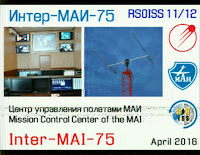Looks like all the pieces are starting to fall into place for the long awaited SSTV event. The schedule is shaping up to look like this:
Setup and activation on April
11 about 18:25 UTC.
Paused April 12 from 12:15 until 14:15 UTC to
allow for a school contact with Romania.
Paused April 13
from 12:45 until 14:30 UTC to allow for a school contact with Argentina.
Deactivation on April 14 at 11:35 UTC.
This opportunity should cover most of the world during the operational period.The image transmissions should be on 145.800 MHz and the mode is planned to be PD180.
In addition, MAI-75 will be conducting two
sessions afterwards. The first one is April 14 from 14:45 until 18:00 UTC. The second
session is on April 15 from 14:10 until 19:00 UTC. These times do not cross N. America but will provide opportunities for Europe, Southeast Asia, Australia and S. America.
As always, all operations aboard the ISS are subject to change and everyone interested in this
activity should be vigilant and patient."
*** Update (April 11, 2016)
Looks like the start will be delayed. Seems the hardware is having issues and not transmitting. Troubleshooting is in work.
*** Update (April 12, 2016)
A faulty connector appears to still be plaguing SSTV operations. I has been working for some periods of time but continues to cause problems for transmissions. It was active over N. America at 20:00 UTC.


































